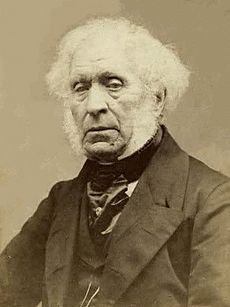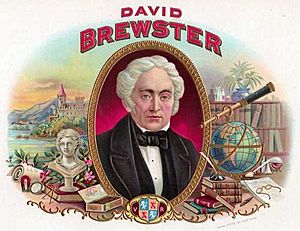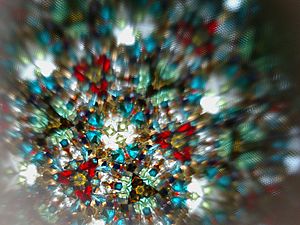David Brewster facts for kids
Quick facts for kids
Sir David Brewster
|
|
|---|---|
 |
|
| Born | 11 December 1781 Canongate, Jedburgh, Roxburghshire
|
| Died | 10 February 1868 (aged 86) Allerly House, Gattonside, Roxburghshire
|
| Nationality | Scottish |
| Citizenship | Great Britain |
| Alma mater | Edinburgh University |
| Known for | Physical optics, Brewster's angle, photoelasticity, stereoscope, kaleidoscope |
| Awards | Copley Medal (1815) Rumford Medal (1818) Keith Prize (1827–9, 1829–31) Royal Medal (1830) |
| Scientific career | |
| Fields | Physics, mathematics, astronomy |
| Influences | Isaac Newton, Étienne-Louis Malus |
| Influenced | James David Forbes |
| Notes | |
|
Founding Director of the Scottish Society of Arts (1821)
Principal of St Andrews University (1837–59) Principal of Edinburgh University (1859–68) |
|
Sir David Brewster (born December 11, 1781 – died February 10, 1868) was a Scottish scientist, inventor, writer, and university leader. He is best known for his important work with light and for inventing the kaleidoscope.
Contents
Early Life and Education
David Brewster was born in Jedburgh, Scotland. His father, James Brewster, was a respected teacher and the head of Jedburgh Grammar School. David was one of six children in his family.
When he was 12 years old, David went to the University of Edinburgh. He studied there to become a minister, and he even preached in churches around Edinburgh a few times. However, he was always very interested in natural science, which is the study of the natural world.
Amazing Inventions and Discoveries
Sir David Brewster made many important discoveries about light, especially how it behaves. He studied how light waves can be made to vibrate in a single direction, a process called polarization. He discovered something called Brewster's angle, which is a special angle where light reflects perfectly without glare.
He was also a pioneer in photography. He improved the stereoscope, a device that lets you see 3D images. His version, called the "lenticular stereoscope," was the first portable device for viewing 3D pictures. He also invented a special camera that could take pictures for these 3D viewers.
One of his most famous inventions, especially for the public, was the kaleidoscope. He invented it around 1815. People loved the kaleidoscope, and it became very popular in the United Kingdom, France, and the United States. It creates beautiful, changing patterns using mirrors and colorful pieces.
Writer and Editor
Besides his inventions, Brewster was also a busy writer and editor. He started writing for the Edinburgh Magazine in 1799. Later, he became the editor of the Edinburgh Encyclopædia, a large collection of knowledge. He wrote many of the science articles himself.
He also contributed to the Encyclopædia Britannica, writing about topics like electricity, magnetism, microscopes, and optics. He helped start and edit several science journals, like the Edinburgh Philosophical Journal and the Edinburgh Journal of Science.
Brewster was also a historian of science. He greatly admired Isaac Newton, the famous scientist. Brewster wrote a detailed book about Newton's life in 1831. He was the first science historian to study many of Newton's private papers.
Family Life
Sir David Brewster was married twice. His first wife was Juliet Macpherson. They had four sons and one daughter. One of their sons, Charles, sadly drowned when he was young. His daughter, Margaret Maria Gordon, later wrote a book about her father's life.
His second wife was Jane Kirk Purnell. They married in 1857.
Sir David Brewster passed away in 1868. He was buried next to his first wife and second son at Melrose Abbey. A building at Heriot-Watt University is named in his honor, celebrating his contributions to science.
Images for kids
See also
 In Spanish: David Brewster para niños
In Spanish: David Brewster para niños





